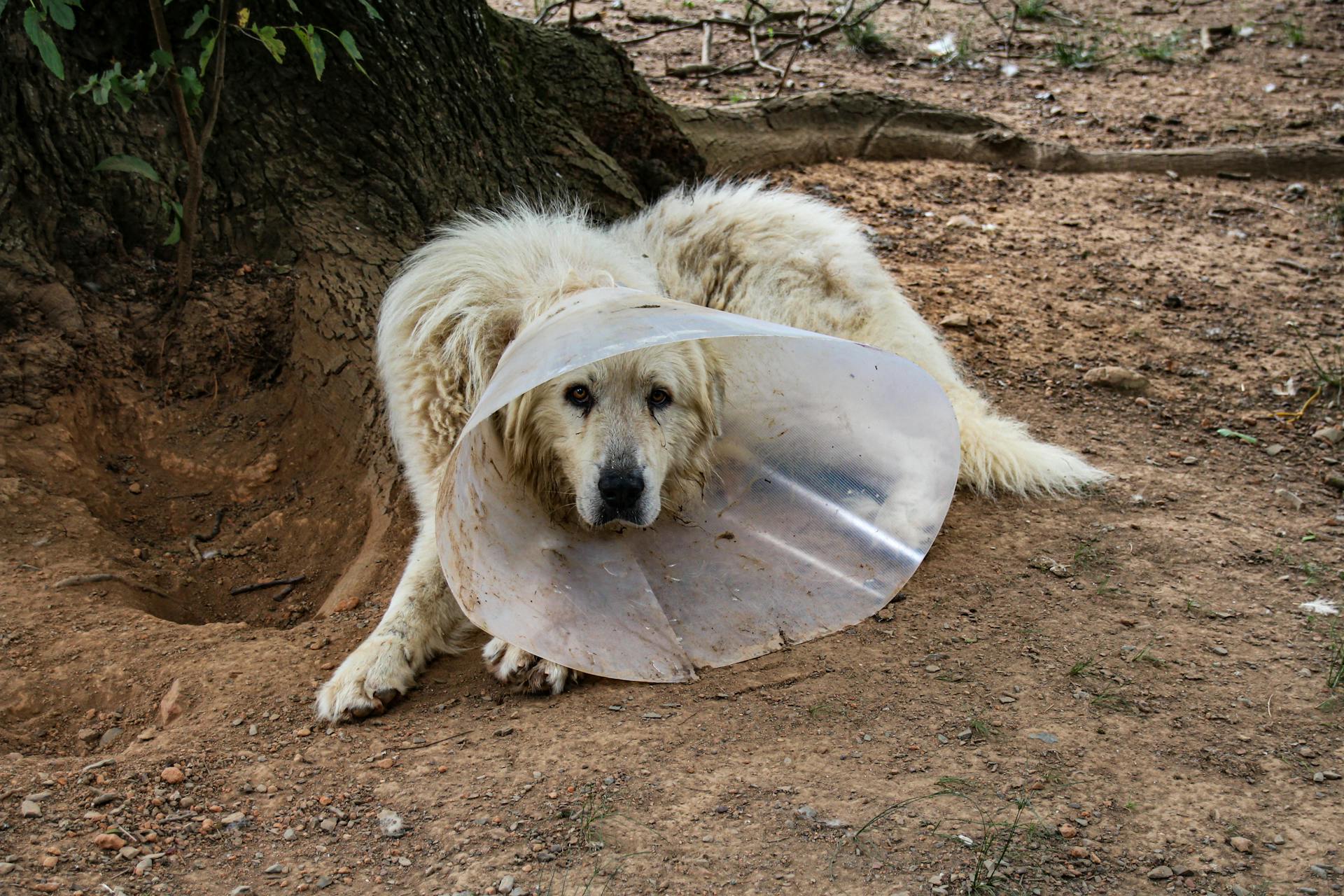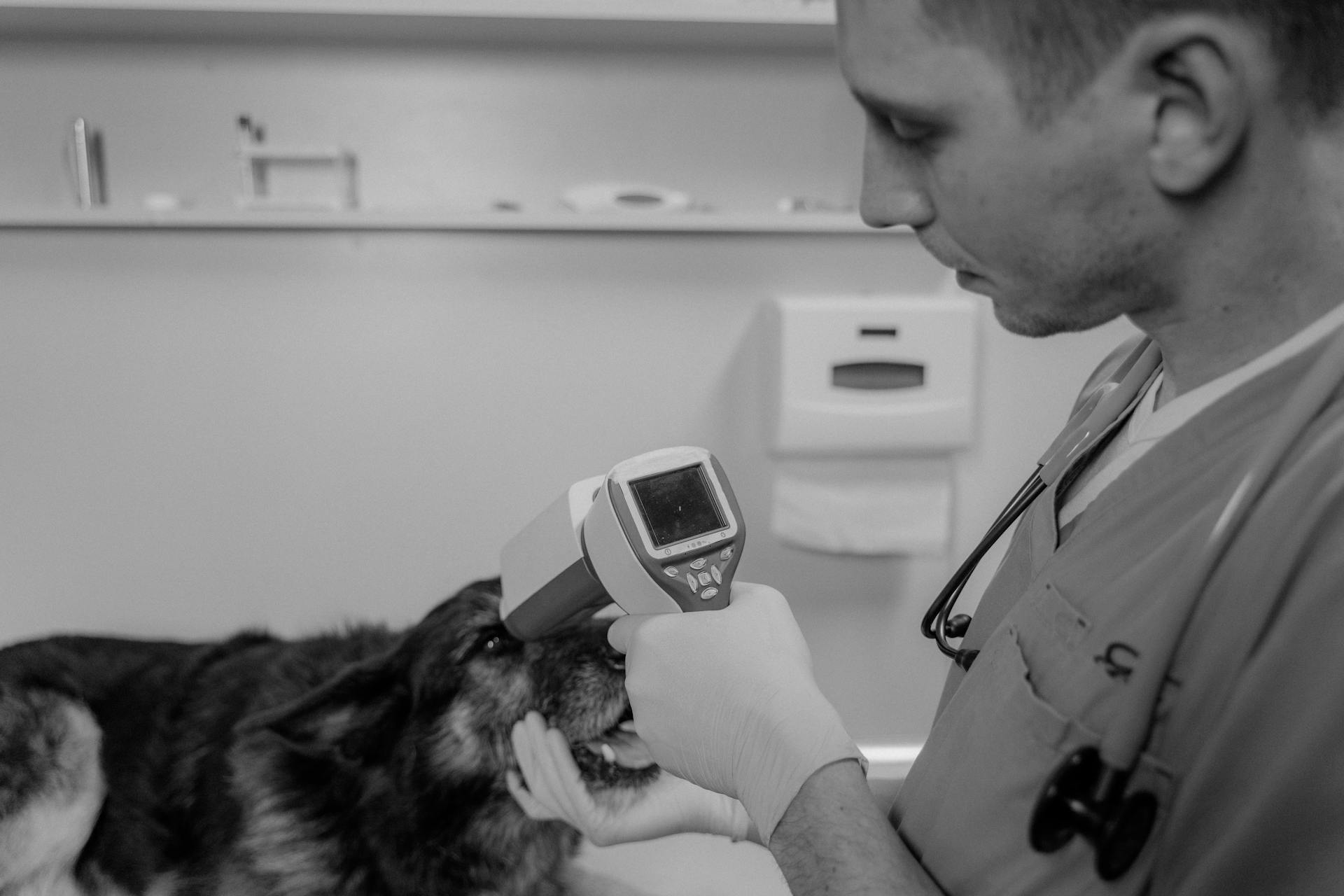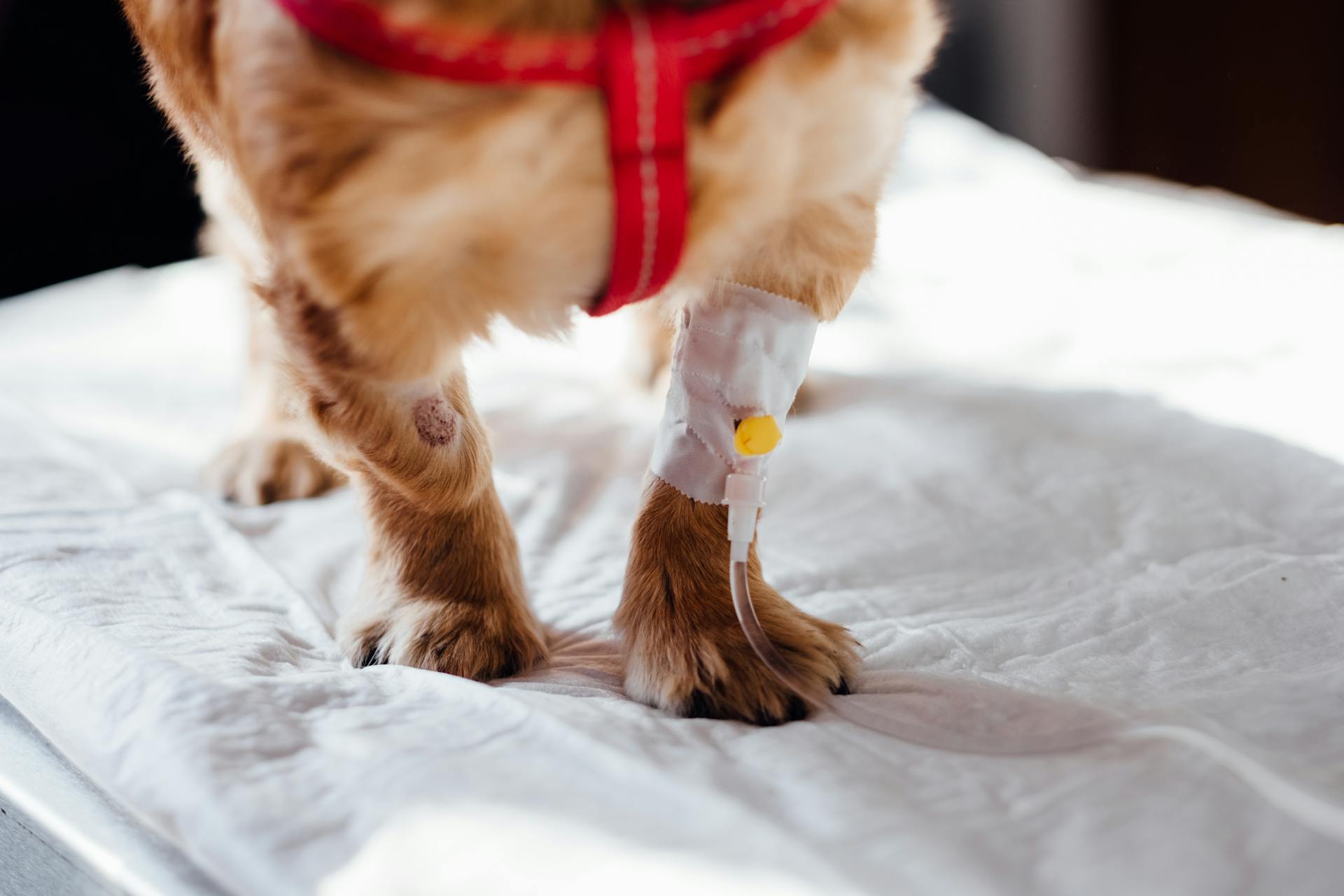
Canine cancer prognosis can be a challenging and uncertain topic for dog owners. The life expectancy of a dog with cancer varies greatly depending on the type of cancer, its stage, and the effectiveness of treatment.
Some cancers, like mast cell tumors, have a relatively high survival rate, with 90% of dogs surviving for at least a year after diagnosis. However, others, like osteosarcoma, are more aggressive and have a poorer prognosis.
Treatment options, such as surgery, chemotherapy, and radiation therapy, can significantly impact a dog's quality of life and life expectancy. The goal of treatment is often to manage symptoms, slow disease progression, and improve the dog's comfort and well-being.
Check this out: Canine Mouth Cancer Life Expectancy
Types of Canine Cancer
Skin cancers are a common type of cancer in dogs, often presenting as lumps and bumps on the skin.
Mast cell disease is another type of skin cancer that affects dogs, and there are other types of skin cancers that can occur either on the skin's surface or just beneath it.
Brain tumors are a serious type of cancer that can affect dogs, requiring prompt veterinary attention.
Hemangiosarcoma is a common cancer in larger breed dogs, so if you have a big dog, it's essential to be aware of this risk.
Lymphoma is a widespread type of cancer in dogs, affecting the lymph system, and it's crucial to catch it early for the best chance of successful treatment.
Bladder cancer is another type of cancer that affects dogs, and like all cancers, early detection is key.
Symptoms and Diagnosis
Cancer in dogs can be difficult to detect, but there are some common signs to look out for, such as lumps and bumps underneath the skin, abnormal odors, and abnormal discharge from the eyes, mouth, ears, or rectum.
Some dogs may exhibit more subtle symptoms, such as lameness, difficulty breathing, or loss of appetite.
If you notice any of these signs in your dog, it's essential to make a veterinary appointment immediately. Your veterinarian will perform a physical examination, take a complete history, and may use diagnostic imaging, such as X-rays or ultrasounds, to determine the cause of the symptoms.
A biopsy or fine needle aspirate may be necessary to confirm a diagnosis of cancer. Your veterinarian may also palpate your dog's lymph nodes, abdomen, and other areas to check for any enlargement or masses.
Here are some common signs of cancer in dogs:
- Lumps or bumps underneath the skin
- Abnormal odors
- Abnormal discharge from the eyes, mouth, ears, or rectum
- Lameness or difficulty breathing
- Loss of appetite
- Weight loss
- Changes in bathroom habits
- Evidence of pain
Early detection and diagnosis are crucial in treating canine cancer. If caught early, cancer can often be removed or treated with surgery or chemotherapy, depending on the type of tumor.
Symptoms
Symptoms of cancer in dogs can be subtle and may vary greatly depending on the type and location of the cancer. Some common signs include lumps and bumps underneath a dog's skin, abnormal odors emanating from the mouth, ears, or other parts of the body, and abnormal discharge from the eyes, mouth, ears, or rectum.
Lameness that doesn't go away and swelling of the affected bone are common symptoms when a tumor affects a limb, particularly in the case of osteosarcoma. Swelling or a mass is often the first sign of a tumor in the skull, jaw, or ribs.
Intriguing read: Lifespan of Dog with Mast Cell Tumor

Cancer in dogs can also cause difficulty eating, neurologic signs such as seizures or a wobbly gait, breathing difficulties, and lameness. Loss of appetite and lethargy are also common symptoms.
Some signs of cancer in dogs are easy to spot, while others are not. You may notice sores that don't heal, bleeding or discharge, loss of appetite, unexplained weight loss, strong odor, and swelling.
Here are some common signs of cancer in dogs:
- Sores that don't heal
- Bleeding or discharge
- Loss of appetite
- Unexplained weight loss
- Strong odor
- Swelling
- Lumps or bumps beneath the skin
- Lethargy, depression, disinterest in exercise
- Difficult or painful breathing or coughing
- Straining when going to the bathroom
- Challenges when eating or swallowing
- Pain or difficulty walking, lameness or stiffness
It's essential to note that many of these symptoms can be caused by other conditions, so if you're concerned about your dog's health, it's always best to consult with a veterinarian.
How a Veterinarian Diagnoses a Dog's Condition
A veterinarian will typically start by taking a comprehensive history of your dog's symptoms and behavior. This will help them understand the overall health of your pet.
They will then perform a physical examination, feeling your dog's entire body for any enlarged organs or masses. This can include a rectal and oral exam to detect hidden tumors.
X-rays are often taken to check for any irregularities, and abdominal ultrasounds can bring any abnormalities to light. Your veterinarian will also palpate your dog's lymph nodes to check for any enlargement, which can be a sign of cancer.
Abnormal blood work can warrant further investigation, but it's not always a sign that your dog may have cancer. Your veterinarian will take a biopsy of any mass or tumor detected to determine if it's cancerous.
Here are some common diagnostic tests used to diagnose cancer in dogs:
- X-rays
- Abdominal ultrasounds
- Blood work (to check for abnormal white and red blood cell counts)
- Biopsy (to determine if a mass or tumor is cancerous)
- Palpation of lymph nodes
It's essential to be aware of changes in your dog's behavior and pay attention to any bumps or lumps you may feel while petting and grooming your dog. If you notice any of these signs, make an appointment with your veterinarian immediately.
Causes and Detection
Early detection of cancer in dogs is crucial for successful treatment and improved outcomes. Most cancers are more amenable to removal when detected early, and treatment options like surgery or chemotherapy are more effective when the cancer is smaller and hasn't spread.
Readers also liked: Canine Lymphoma When to Euthanize
Veterinarians detect cancer in dogs through clinical testing, diagnostic imaging, and laboratory tests. Detecting cancer in dogs is a multi-faceted process that relies heavily on a veterinarian's expertise as well as vigilant observation from pet owners.
Some common ways veterinarians detect signs of cancer in dogs include:
- Physical Examination and History Assessment
- Diagnostic Imaging (X-rays and abdominal ultrasounds)
- Palpation of Lymph Nodes
- Laboratory Testing (including biopsies)
Certain large and giant dog breeds, such as German Shepherds, Saint Bernards, Rottweilers, and Greyhounds, may have an increased genetic risk for developing osteosarcoma, a common bone cancer in dogs.
How to Detect
Detecting cancer in dogs requires a combination of your veterinarian's expertise and your own vigilance. Your veterinarian will conduct a physical examination, feeling your dog's entire body for any enlarged organs or masses. They may also detect hidden tumors through rectal and oral exams.
Sharing your dog's history with your veterinarian is essential to their understanding of your pet's overall health. Your veterinarian will ask about your dog's symptoms, medical history, and lifestyle to help identify potential cancer risks.

Veterinarians use various diagnostic tools to detect cancer in dogs, including X-rays, abdominal ultrasounds, and palpation of lymph nodes. Abnormal blood work can also be a sign that your dog may have cancer, but it's not always a definitive indicator.
Here are some common ways veterinarians detect cancer in dogs:
- Physical Examination and History Assessment: Your veterinarian will conduct a comprehensive physical examination, feeling your dog's entire body and checking for any enlarged organs or masses.
- Diagnostic Imaging: X-rays and abdominal ultrasounds are used to check for any irregularities.
- Palpation of Lymph Nodes: Your veterinarian will palpate your dog's lymph nodes to check for any enlargement, which can be a sign of cancer.
- Laboratory Testing: Abnormal blood work can be a sign that your dog may have cancer, but it's not always a definitive indicator.
Fine needle aspirate and biopsies are also used to diagnose cancer in dogs. Your veterinarian may take a sample of a tumor or lump and examine it under a microscope to determine if it's cancerous. In some cases, a biopsy may be performed to remove a small sample of tissue for further analysis.
What Causes?
Osteosarcoma, or bone cancer, is the most common bone cancer seen in dogs, affecting dogs of all ages and frequently causing pain.
Certain large and giant dog breeds, such as German Shepherds, Saint Bernards, Rottweilers, and Greyhounds, may have an increased genetic risk for developing this type of cancer.
Here's an interesting read: Canine Bone Marrow Cancer

Genetics and environmental factors may play a role in the development of osteosarcoma, although the exact cause is not known.
Exposure to certain toxins can increase the likelihood of a dog developing osteosarcoma.
Osteosarcoma can also develop in bones that have experienced previous trauma, including radiation therapy sites, previously healed fractures, and previous bone infections (osteomyelitis).
Regular check-ups with your veterinarian are highly recommended to catch any potential signs or symptoms early on.
Is in Common?
Cancer in dogs is very common, and it's probably one of the most frequently diagnosed diseases in veterinary medicine.
As we age, our furry friends are more likely to develop cancer, with most cases occurring after about the age of nine.
Yes, cancer in dogs is relatively common, and we tend to see a fair amount in dogs as they age.
Unfortunately, this means that many dogs will face a cancer diagnosis at some point in their lives, and it's essential to be aware of the risks and signs to catch it early.
We see cancer in dogs after about the age of nine, but it can also occur in younger dogs, so it's crucial to monitor their health closely regardless of age.
For your interest: Dogs Aging Chart
Diagnosis and Staging
Osteosarcoma, a common type of cancer in dogs, requires a thorough diagnostic process to determine its root cause. Your vet will take an X-ray and perform a physical and orthopedic examination to rule out other causes of lameness.
In over 90% of dogs, the tumor will have already metastasized at the time of diagnosis, and osteosarcoma most commonly spreads to the lungs. Chest X-rays or a computed tomography (CT) scan, blood tests, and a urinalysis will usually be performed to assess your dog's overall health.
A biopsy is necessary to obtain a definitive diagnosis and determine the best treatment plan for your dog. Any problem areas identified on the X-ray will be biopsied for further analysis.
Fine needle aspirate, where a needle is inserted into a solitary tumor, can be diagnostic in some cases. The sample is then sent to a laboratory for histopathology to analyze the tumor's characteristics.
In some cases, your vet may perform a biopsy by removing the whole tumor and sending it to a laboratory for analysis. This can help determine if the tumor had reasonable margins and what its recurrence rate might be.
Broaden your view: Mast Cell Tumor in Pit Bulls
Treatment and Aftermath
Amputation is a common treatment for osteosarcoma, where the affected limb is removed followed by chemotherapy to treat metastasis.
Many dogs can function well with three legs if they're otherwise healthy. Limb-sparing surgery is also an option in some cases, but it comes with a higher complication rate.
Stereotactic radiation can be beneficial when surgery isn't an option due to tumor location, and it's also an alternative to amputation for dogs with limited bone destruction.
Palliative treatment aims to make your pet more comfortable, but it doesn't provide a cure and can include conventional radiation therapy and pain-reducing drugs.
Dogs can tolerate chemotherapy better than humans, and there are many medications available to manage side effects like nausea.
Treatment Options
Osteosarcoma in dogs can be treated with amputation, which is the most common treatment, followed by chemotherapy to treat metastasis.
Limb-sparing surgery is an option for some dogs, but the complication rate is relatively high, particularly infection.
Stereotactic radiation can be beneficial when surgery isn't an option due to tumor location, and it can also be an alternative to amputation for dogs in which the osteosarcoma hasn't destroyed a great deal of bone.
Palliative treatment is recommended to make your pet more comfortable, but it doesn't provide a cure and can include conventional radiation therapy and drugs to reduce pain.
Surgical options are available for dogs with cancer, and chemotherapy is also an option.
Radiation Treatment Aftermath
The recovery process from radiation therapy for osteosarcoma can be a challenging time for your dog. The most common side effects are a sunburn-like effect on the skin in the treatment field, and fur loss in that area with white fur regrowth.
It's essential to keep your dog quiet on the affected limb, avoiding running, jumping, and excitement, as there's an increased risk for fracture. This means no playing fetch or going for walks without a harness.
Your dog will need plenty of rest and quality nutrition to aid in the healing process. Pain medications may be prescribed by your veterinarian if needed.
Because osteosarcoma is an aggressive cancer, it's vital to work closely with your veterinarian to monitor for signs of recurrence or progression of the cancer, including metastasis. Early detection is critical for ensuring successful treatment outcomes.
Frequently Asked Questions
Should I treat my 13 year old dog for cancer?
Treatment decisions are based on a pet's overall health, not age, so a 13-year-old dog's cancer diagnosis will be evaluated on a case-by-case basis. Let's discuss your dog's specific situation to determine the best course of action.
Sources
- https://www.lombardvet.com/services/dogs/dog-cancer
- https://petcureoncology.com/what-you-should-know-about-osteosarcoma-bone-cancer-in-dogs/
- https://www.ahofstatesville.com/services/dogs/dog-cancer
- https://www.springhouseanimalhospital.com/site/blog/2021/11/18/tumors-in-dogs
- https://www.thedrakecenter.com/services/dogs/dog-cancer
Featured Images: pexels.com


